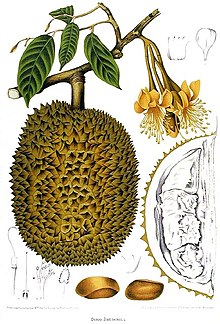Durio zibethinus
| Durio zibethinus | |
|---|---|
 |
|
| Scientific classification | |
| Kingdom: | Plantae |
| (unranked): | Angiosperms |
| (unranked): | Eudicots |
| (unranked): | Rosids |
| Order: | Malvales |
| Family: | Malvaceae |
| Subfamily: | Helicteroideae |
| Tribe: | Durioneae |
| Genus: | Durio |
| Species: | D. zibethinus |
| Binomial name | |
|
Durio zibethinus L. |
|
 |
|
| Native distribution of D. zibethinus Exotic distribution of D. zibethinus | |
| Synonyms | |
|
|
| Nutritional value per 100 g (3.5 oz) | |
|---|---|
| Energy | 615 kJ (147 kcal) |
|
27.09 g
|
|
| Dietary fiber | 3.8 g |
|
5.33 g
|
|
|
1.47 g
|
|
| Vitamins | |
| Vitamin A | 44 IU |
| Thiamine (B1) |
(33%)
0.374 mg |
| Riboflavin (B2) |
(17%)
0.2 mg |
| Niacin (B3) |
(7%)
1.074 mg |
| Pantothenic acid (B5) |
(5%)
0.23 mg |
| Vitamin B6 |
(24%)
0.316 mg |
| Folate (B9) |
(9%)
36 μg |
| Vitamin C |
(24%)
19.7 mg |
| Minerals | |
| Calcium |
(1%)
6 mg |
| Iron |
(3%)
0.43 mg |
| Magnesium |
(8%)
30 mg |
| Manganese |
(15%)
0.325 mg |
| Phosphorus |
(6%)
39 mg |
| Potassium |
(9%)
436 mg |
| Sodium |
(0%)
2 mg |
| Zinc |
(3%)
0.28 mg |
| Other constituents | |
| Water | 65g |
| Cholesterol | 0mg |
|
Edible parts only, raw or frozen.
Refuse: 68% (Shell and seeds) Source: USDA Nutrient database |
|
|
|
| Percentages are roughly approximated using US recommendations for adults. Source: USDA Nutrient Database |
|
Durio zibethinus is the most common tree species in the genus Durio that are known as durian and have edible fruit also known as durian.
As with other durian species, the edible flesh emits a distinctive odour that is strong and penetrating even when the husk is intact. Some people regard the durian as having a pleasantly sweet fragrance; others find the aroma overpowering and revolting. The smell evokes reactions from deep appreciation to intense disgust, and has been described variously as rotten onions, turpentine, and raw sewage. The persistence of its odour has led to the fruit's banishment from certain hotels and public transportation in Southeast Asia.
There are 30 recognised Durio species, at least nine of which produce edible fruit. Durio zibethinus is the only species available in the international market: other species are sold in their local regions. There are hundreds of cultivars of Durio zibethinus; many consumers express preferences for specific cultivars, which fetch higher prices in the market.
The wood of D. zibethinus is reddish brown. Durio zibethinus is a medium to large buttressed tree, up to 45 m tall in dense lowland forests and 10-15 m in orchards and backyards; Bark dark red brown, peeling off irregularly. Leaves are elliptic or lanceolate-elliptic, 10-15 cm long, 3-4 cm wide, papery; base acute; apex acuminate, upper surface glabrous, glossy, lower surface densely covered with silvery or golden scales; secondary veins in about 15 pairs, distinctly looping near the margin; venation indistinct below. Petioles 1 -1.5 cm long, angular. Flowers are in fascicles of corymbose inflorescences. Pedicels 5-7 cm long; Calyx saccate, flattened at the base, with tube about 2 cm long and 1.5 cm in diameter; Petals white or creamy, spatulate, 5 cm long and 2 cm wide at the broadest part. Scientific Classification Kingdom: Plantae (unranked): Angiosperms (unranked): Eudicots (unranked): Rosids Order: Malvales Family: Malvaceae Subfamily: Helicterioideae Tribe: Durioneae Genus: Durio Species: D. zibethinus Murr Common Name Durian, Civet-fruit Figure 12 shows the tree (A), flowers (B), longitudinal section of fruit (C) and fruit showing conspicuous spines (D) of Durio zibethinus Stamen white, 4 cm long in 5 distinct phalanges, each filament with up to 12 reniform anthers dehiscing by a slit. Ovary is ovoid; Style slender, 4 cm long, stigma yellow. Fruit varies greatly in size; 15-25 cm in diameter, green to yellowish brown, with spines that are variable in length and shape. Seeds are chestnut brown, completely enclosed in a thick, white or yellow, soft, sweet, fragrant aril.
...
Wikipedia
